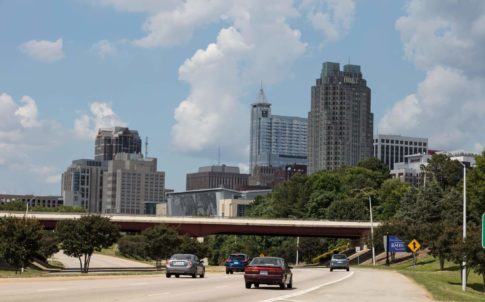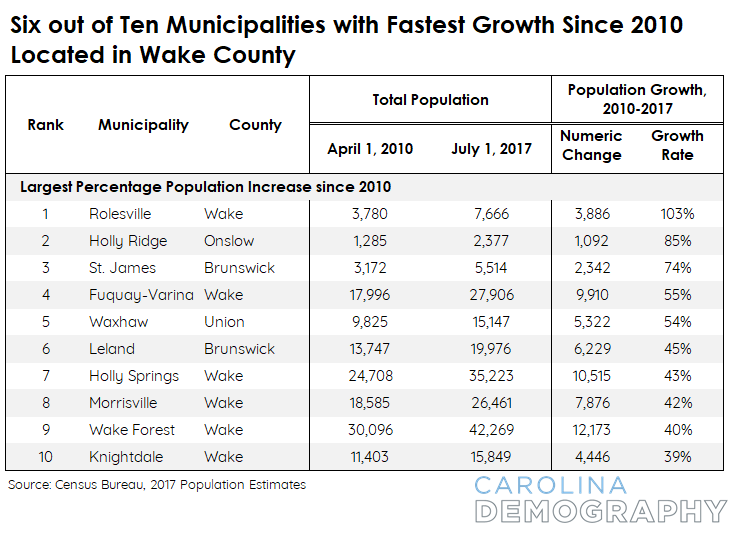NC’s Metropolitan Areas Central to Growth Since 2010

Topline data from the Census Bureau’s recently released 2017 municipal population estimates shows little change from previous years’ estimates. Municipalities located near major metropolitan areas continue to grow, while North Carolina’s rural communities continue to experience population decline.
255 NC municipalities, or 46%, have experienced either population decline or zero-percent growth since 2010. Adding municipalities with stagnant growth – i.e. those that grew slower than the state growth rate of 8% – this totals over three in four municipalities in the state (77%). Just 125 municipalities are growing on par or faster than the state since 2010, many of which are located around the Charlotte, Triangle, and Wilmington metropolitan areas.


The ten municipalities with the largest percentage growth from 2010 to 2017 were ranked in the top ten in 2016, as well. More than half—6 out of 10—are in Wake County. The remaining are represented by Brunswick County (St. James and Leland), Onslow County (Holly Ridge), or Union County (Waxhaw). St. James, Leland, and Holly Ridge are located in the southeastern portion of the state – notable for its high appeal to retirees and rapid growth in this decade – while Waxhaw falls within the Charlotte metro area.
All municipalities in this list have increased by over a third or more of their 2010 population. Rolesville (Wake County), the fastest-growing municipality in the state, has officially doubled its population in less than a decade, growing by 3,853 residents or 103% since 2010. Nonetheless, the majority of these fastest-growing municipalities appear to have hit their growth peak in this decade; just three municipalities experienced their single-largest year of numeric growth in 2017 – Knightdale, Morrisville, and Leland.

The top 10 municipalities with the greatest numeric growth since 2010 also experienced no change since last year’s estimates. This list is comprised entirely of principal cities in North Carolina’s major metros, or their neighboring suburbs with populations of 40,000 inhabitants or more. The combined numeric growth of these ten municipalities accounted for nearly half of the total state population growth (47%) from July 1, 2010 to July 1, 2017.
2017 was also a banner year for several of these municipalities with the largest numeric growth over the decade. From July 1, 2016 to July 1, 2017, Wilmington (New Hanover), Concord (Cabarrus), and Apex (Wake) experienced their single-largest year of growth. This suggests a continuing pattern of growth around metro suburbs, and a shift towards southeastern North Carolina.
Errata Note: A previous version of this blog incorrectly listed the entry for “Apex” as “Winston-Salem”, and vice versa, in the second table (Largest Numeric Growth). All data is correct in both tables, and the two entries have been corrected.
Need help understanding population change and its impacts on your community or business? Carolina Demography offers demographic research tailored to your needs.
Contact us today for a free initial consultation.
Contact UsCategories: Carolina Demographics
Tags: 2017 population estimates, census population estimates, municipal, municipalities, North Carolina, population change, population estimates, population growth, U.S. Census Bureau

The Center for Women’s Health Research (CWHR) at the University of North Carolina School of Medicine released the 12th edition of our North Carolina Women’s Health Report Card on May 9, 2022. This document is a progress report on the…

Dr. Krista Perreira is a health economist who studies disparities in health, education, and economic well-being. In collaboration with the Urban Institute, she recently co-led a study funded by the Kate B. Reynolds Foundation to study barriers to access to…

Our material helped the NC Local News Lab Fund better understand and then prioritize their funding to better serve existing and future grant recipients in North Carolina. The North Carolina Local News Lab Fund was established in 2017 to strengthen…
Your support is critical to our mission of measuring, understanding, and predicting population change and its impact. Donate to Carolina Demography today.